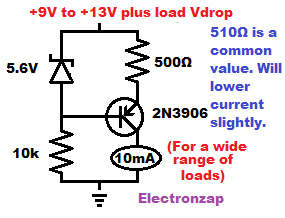Table of Contents
Current can be set through a Bipolar Junction Transistor (BJT) with a zener diode and resistor.

When using a PNP BJT, you can use a zener diode to set the Base voltage to a voltage less than whatever the positive supply voltage is.
The Emitter of a PNP BJT current Source, has a resistor that heads to the positive supply. The emitter tries stay 0.6V higher than the voltage at the PNP BJT Base. If you use a reverse biased 5.6V zener diode on the high side (more positive) of the Base, then the Emitter will stay at 5V less than whatever the positive supply voltage is. That means that there will be 5V across the Emitter’s current setting resistor.
The current that flows through the emitter resistor also flows through the emitter to collector of the PNP BJT, and any load or lack there of from Collector to ground. They all pass the current set by the resistor as long as there is enough supply voltage to do so. The supply voltage needs to be higher than the voltage across the emitter resistor and whatever is across the load at that current.
Good topics to check out next:
To support this site, check out the following links:
- Check out my YouTube videos! https://www.youtube.com/c/Electronzap/videos
- Products I used in my videos or otherwise think look like a good buy. As an Amazon associate, I earn from qualifying purchases. https://www.amazon.com/shop/electronzapdotcom
- Information on this site is not guaranteed to be accurate. Always consult the manufacturer info/datasheet of parts you use. Research the proper safety precautions for everything you do.
- Electronzap is a participant in the Amazon Services LLC Associates Program, an affiliate advertising program designed to provide a means for sites to earn advertising fees by advertising and linking to amazon.com.